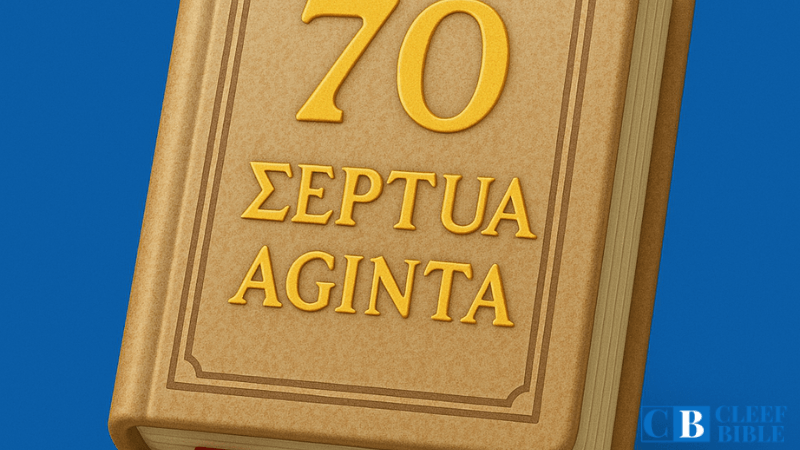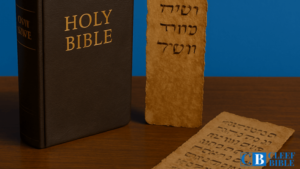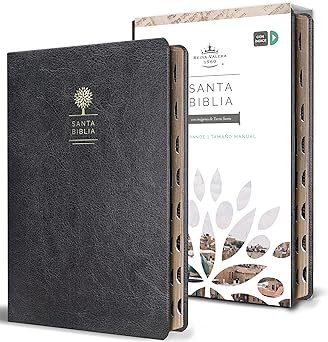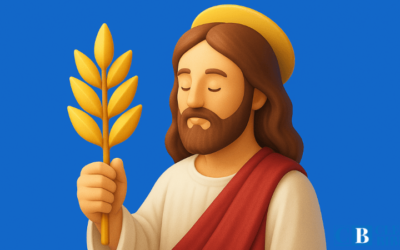What if the Bible used by Jesus and the apostles wasn't exactly the same as the one you hold in your hands today?
What if there was an older version that shaped the thinking of early Christians and informed the New Testament?
That version exists, and it's called the Septuagint.
In this article, you'll discover what it is, why it was so crucial to biblical history, and how it continues to impact our faith today.
Introduction to the Septuagint
Understanding the Septuagint is essential to interpreting the history of the Bible and its influence on the ancient world.
Here I explain in detail its most relevant aspects:
What is the Septuagint and why is it so important?
The Septuagint is the Greek translation of the Hebrew Old Testament.
It was made between the 3rd and 2nd centuries BC in Alexandria, Egypt, primarily for Jews living in the Diaspora who did not speak Hebrew.
This version was widely used in Jesus' time and became the Bible of early Christians.
Many Old Testament quotations in the New Testament come directly from the Septuagint, making it central to understanding the connection between the two covenants.
It also allowed Gentiles access to the Hebrew Scriptures in the common language of the Greco-Roman world, opening the door to evangelism beyond the Jewish people.
The origin of its name and its numerical symbolism (LXX)
The term “Septuagint” comes from Latin Septuagint, which means “seventy.”
This refers to the legend that 70 or 72 Jewish sages were summoned by Pharaoh Ptolemy II Philadelphus to translate the Torah into Greek.
The story goes that, working separately, they all produced exactly the same translation, which was considered a divine miracle.
Although this narrative has legendary overtones, it gave rise to the use of the symbol “LXX” (Roman numeral for 70) as the official abbreviation for the Septuagint.
This number not only symbolizes the translators, but also reflects the perception of inspiration and authority that was given to this version in Hellenistic Judaism.
Historical, theological and cultural relevance
The Septuagint was not just a linguistic work, but a bridge between cultures.
It served as a textual basis for the spread of Christianity in the Greco-Roman world and shaped early Christian theology.
Furthermore, its influence extended to the liturgy, patristic commentaries, and later biblical versions such as the Vulgate.
It was key to the development of the Christian canon, as it included deuterocanonical books that would later become part of the Catholic Bible.
Culturally, it represented an act of preserving the Jewish faith in a world dominated by the Greek language and thought.
And spiritually, it prepared the way for the messianic prophecies to be understood and proclaimed by the apostles in terms accessible to the Gentile world.
Historical context of the Septuagint
To understand the birth of the Septuagint, it is necessary to understand the historical and cultural context in which it was created.
Here are the key factors that explain it:
The Hellenistic Empire and the spread of Greek
Following the conquests of Alexander the Great in the 4th century BC, Greek became the common language in vast regions of the Mediterranean.
This process of Hellenization not only affected commerce and politics, but also education, religion, and daily life.
Koine Greek established itself as the universal language, displacing local languages such as Hebrew in many Jewish communities outside Palestine.
This phenomenon created a new generation of Jews who thought and spoke in Greek, but no longer clearly understood the Hebrew Scriptures.
The Jewish Diaspora in Alexandria
Alexandria, Egypt, was a cosmopolitan city with a large Jewish community.
Many of these Jews were descendants of exiles or emigrants who had settled there for economic, social or political reasons.
In this multicultural context, the Alexandrian Jews adopted Greek as their primary language, while maintaining their religious identity.
This created a strong need to adapt the Scriptures to their new language so as not to lose the connection with their faith and traditions.
The need for a Greek Bible for Hellenized Jews
As time passed, many Diaspora Jews could no longer read Hebrew or Aramaic.
This made teaching, worship, and personal access to the Scriptures difficult.
To preserve the faith and facilitate the spiritual life of these believers, the initiative arose to translate the Hebrew Bible into Greek.
Thus the Septuagint was born: as a pastoral, educational and cultural effort to ensure that the Hellenized Jewish people would not lose their spiritual roots.
Translation process of the Septuagint
The creation of the Septuagint was surrounded by history, legend, and theological relevance.
Let's see how this monumental project developed:
The legend of the 70 translators in Alexandria
According to the tradition recorded in the Letter of Aristeas, King Ptolemy II asked 72 Jewish scholars to translate the Torah into Greek for inclusion in the Library of Alexandria.
Each worked in isolation, but in the end they all produced identical versions, which was interpreted as a divine sign.
Although this story may be partly symbolic, it illustrates the perceived unity, authority, and fidelity of the translated text.
From then on, the number 70 (LXX) became a symbol of the Septuagint and its supposed miraculous origin.
Translation of the Pentateuch and later books
The first step was to translate the five books of Moses, known as the Pentateuch.
This part was the most carefully crafted, as it formed the basis of the Jewish faith.
Later, other Old Testament books were translated, including historical, wisdom, and prophetic books.
Some of these books—such as Wisdom, Ecclesiasticus, and Maccabees—were not in the Hebrew canon, but were included in the Septuagint, which created differences with the later Jewish canon.
Was it really an inspired translation?
For many early Christians, the Septuagint was more than just a translation: it was the Word of God.
They used it in preaching and considered it authoritative, especially when the quotations coincided with Jesus' teaching.
The Church Fathers, such as Augustine and Justin Martyr, defended his divine authority.
Even today, some churches—such as the Eastern Orthodox—regard the Septuagint as their official Old Testament.
However, within Judaism, its status declined over time, especially as Christians began to use it to support messianic doctrines.
Even so, the spiritual, historical, and theological influence of the Septuagint is unquestionable, and it remains an object of study and reverence.
Content and scope of the Septuagint
The Septuagint not only translated existing texts, but also defined the scope of the Old Testament for many generations.
Here I explain its composition and influence:
Books included: canonical and deuterocanonical
The Septuagint contains all the books of the Hebrew canon, known as the Law (Torah), the Prophets (Nevi'im), and the Writings (Ketuvim).
But it also includes other books not found in the later Jewish canon, called deuterocanonical by the Catholic Church or apocryphal by the Protestant reformers.
These additional books include:
- Tobias
- Judith
- Wisdom
- Ecclesiasticus (Sirach)
- Baruch
- 1 and 2 Maccabees
- Additions to Esther and Daniel
These texts formed an integral part of the spirituality of the Hellenized Jewish community and, later, of the early Christian Church.
Differences with the Hebrew canon (Tanakh)
The Hebrew Tanakh has a different number of books and a different organization.
For example, the Minor Prophets are grouped into one book and Ezra and Nehemiah are considered one.
The Septuagint, on the other hand, divides the books further and adds the deuterocanonical ones, expanding the collection of sacred texts.
It also presents textual variations that, in some cases, are cited by the New Testament instead of the Hebrew text.
These differences led to debates between Jews and Christians over which should be considered the true canon, especially after the first century AD.
Which Christian versions adopted its content?
The Catholic Church, at the Council of Carthage (397 AD) and then at the Council of Trent (16th century), confirmed many of the books included in the Septuagint as canonical.
The Orthodox Church also adopts the Septuagint as the basis of its Old Testament.
The most influential versions based on the Septuagint are:
- The Latin Vulgate (in part)
- The Greek Orthodox Bible
- Some modern versions of interlinear study
In contrast, many Protestant Bibles use the Hebrew canon (Tanakh) as their basis, excluding the deuterocanonical books.
Use of the Septuagint in Biblical Times
In the centuries before and after the birth of Christ, the Septuagint played a central role in the religious life of believers.
Here I show you how it was used:
Reading in Greek synagogues
In the synagogues of the Diaspora, where Greek was the common language, the public reading of the Scriptures was done in the Septuagint version.
This practice facilitated access to the sacred text to people who no longer understood ancient Hebrew or Aramaic.
The Septuagint was also an educational tool to teach Gentile children and converts the basics of Israel's faith.
Its liturgical use strengthened the Hellenized Jewish identity and allowed the oral transmission of the Scriptures in a different cultural context.
Use by Jews before Christianity
Before the rise of Christianity, the Septuagint was already widely accepted by many Jewish groups.
It was used by philosophers such as Philo of Alexandria and in later Aramaic translations and commentaries.
The Dead Sea Scrolls also show that some Septuagint texts matched ancient Hebrew manuscripts, reinforcing their textual legitimacy in the Second Temple period.
Over time, however, the use of the Septuagint declined among Palestinian Jews because of its growing association with Christians.
Reception of the Septuagint in Palestine
In the Holy Land, the use of the Septuagint was more limited than in the diaspora.
The rabbis of Palestinian Judaism preferred the traditional Hebrew text and distrusted the Greek translations.
After the rise of Christianity and its extensive use of the LXX to prove that Jesus was the Messiah, the reaction was even stronger.
In the 2nd century, Rabbinic Judaism actively promoted other translations (such as those of Aquila or Theodotion) to replace the Septuagint.
However, in the early centuries of Christianity, Palestine was also a meeting point of traditions, and it is very likely that the Septuagint had some residual influence in mixed communities.
The Septuagint in the New Testament
The influence of the Septuagint on early Christianity was profound and evident in the text of the New Testament itself.
Here's how the New Testament authors used this version:
Quotes from the LXX by Jesus and the apostles
Many of the Old Testament passages cited in the Gospels and apostolic letters are taken directly from the Septuagint.
Jesus, in his teachings, used phrases that match the LXX more closely than the traditional Hebrew text.
For example, in Luke 4:18, Jesus quotes Isaiah 61 with words that reflect the Greek translation, not the original Hebrew.
The apostles also constantly drew on the LXX to preach to a Greek-speaking audience.
This facilitated the spread of Christianity, as the message was communicated in an understandable language and with familiar references.
Messianic texts used by early Christians
The early Christians found in the Septuagint a powerful tool to show the prophetic fulfillment in Jesus.
Passages such as Isaiah 7:14 (“a virgin shall conceive”) or Psalm 22 were used to explain the incarnation, crucifixion, and resurrection of Christ.
In many cases, the Greek translation of these texts contained nuances that reinforced Jesus' messianic identity.
This led to the LXX being seen as “the Bible of early Christianity.”
By using the Septuagint, the apostles could show both Hellenized Jews and Gentiles how the Scriptures foretold the Messiah.
How the LXX Supported the Proclamation of the Gospel
The Septuagint allowed the evangelists to effectively reach a Greco-Roman world.
It served as a cultural and spiritual bridge between Judaism and nascent Christianity.
The authors of the New Testament wrote in Greek and assumed that their readers knew the Scriptures in that language.
The LXX not only supported his theological arguments, but validated the fulfillment of the prophecy in accessible language.
Thanks to the Septuagint, the Gospel message was proclaimed with scriptural authority from the beginning of the Church.
Comparison with other Bible versions
To understand the importance of the Septuagint, it is helpful to compare it with other key translations.
These comparisons reveal their strengths and their most significant textual differences:
Septuagint vs. Masoretic Text
The Masoretic Text (MT) is the standardized Hebrew version of the Old Testament, compiled by Jewish scholars between the 7th and 10th centuries AD.
Compared to the Septuagint, the MT has differences in wording, structure and even content.
For example, some psalms are organized differently, and certain verses are shorter or longer.
In Jeremiah, the LXX version is shorter and ordered differently than the MT.
These variations have generated debates about which best represents the original text.
Many scholars believe that the LXX preserves older readings in certain cases.
Septuagint vs. Vulgate
The Vulgate, translated by Saint Jerome in the 4th century AD, is a Latin version that was based primarily on the Hebrew Text, but also incorporated elements of the LXX.
Jerome consulted both sources, but preferred Hebrew as a “purer” basis for his translation.
However, due to liturgical tradition, several deuterocanonical books were included in the Vulgate according to the Septuagint version.
This made the Vulgate a hybrid work, influenced by both worlds.
Both versions were fundamental for the Church: the LXX in the East, and the Vulgate in the West.
Septuagint and modern translations
Modern Spanish translations (such as the Reina-Valera or the Jerusalem Bible) have been influenced to varying degrees by the Septuagint.
Some, such as the Jerusalem Bible or the Nacar-Colunga, consult the LXX to improve the understanding of complex passages.
The Reina-Valera, however, primarily follows the Masoretic Text for the Old Testament.
Today, several scholarly editions include critical apparatus comparing the LXX with the MT to help the reader understand the differences.
Studying the Septuagint enriches modern biblical interpretation and offers a broader understanding of the textual history of Scripture.
Theological value of the Septuagint
Beyond its linguistic and cultural usefulness, the Septuagint has a significant theological weight in the history of Christianity.
Below, we explore its doctrinal relevance and influence in the early centuries of the Church:
His contribution to the understanding of messianic prophecy
Many passages in the Septuagint contain formulations that highlight or clarify the messianic character of certain prophecies.
For example, Isaiah 7:14 in the LXX translates “almah” (young man) as “parthenos” (virgin), which was crucial to the Christian argument about the virgin birth of Jesus.
Also in the Psalms, Daniel, and Isaiah, the Greek formulations seem to align with events in Christ's life, reinforcing the idea of prophetic fulfillment.
This made the LXX a key source for Christological theology from the 1st century onwards.
Key terms in Greek and their Christian interpretation
Words like “Kyrios” (Lord), “Logos” (Word), and “Soter” (Savior) in the Septuagint directly influenced the theological terminology of the New Testament.
Jesus is called “Kyrios” in the same sense as the name of God in the Old Testament.
John’s prologue (“In the beginning was the Logos…”) has deep roots in LXX theology.
The way the Septuagint translated Hebrew concepts shaped the doctrinal vocabulary of nascent Christianity.
Use of the LXX in Patristic Theology
The Church Fathers, such as Augustine, Origen, and Justin Martyr, considered the Septuagint to be inspired by God.
It was his reference version in debates with heretics, Jews and pagan philosophers.
Many patristic commentaries on the Old Testament are based exclusively on the Septuagint text.
Even when other translations emerged, the LXX remained the theological standard in the Eastern (and partly in the Western) tradition.
Controversies and rejection among some Jews
Despite its initial acceptance, the Septuagint became a point of conflict in the relationship between Christianity and Judaism.
Here are the historical and theological reasons for the estrangement:
The separation from Rabbinic Judaism
Following the destruction of the Second Temple in 70 AD, Rabbinic Judaism consolidated its identity around the Hebrew text and oral tradition.
Since Christians used the Septuagint to prove Jesus' messiahship, the rabbis began to distance themselves from this version.
The LXX was seen as “contaminated” by Christian interpretation, which led to its progressive abandonment in Jewish communities.
The shared use of Scripture became a theological boundary between the two faiths.
Replacement by the Masoretic Text in Judaism
From the 2nd century AD, the Masoretic Text became established as the official version of Judaism.
This text was preserved, vocalized and systematized by the Masoretes between the 6th and 10th centuries AD.
By focusing exclusively on Hebrew, the rabbis rejected the legitimacy of the Septuagint as a faithful representation of the Tanakh.
This replacement marked a definitive separation between the textual bases of Judaism and Christianity.
Persistence of the LXX in Orthodox Christianity
In contrast to the Jewish rejection, Eastern Orthodox Christianity adopted the Septuagint as its authoritative version of the Old Testament.
To this day, churches such as the Greek, Russian, and Serbian use it in liturgies, theology, and catechesis.
This fidelity to the LXX keeps alive a textual tradition that dates back to the 3rd century BC.
In addition, it has been a source of biblical translations into Slavic, Armenian, Georgian, and other Eastern Christian traditions.
The Septuagint, then, survives not only as a historical testimony, but as a living voice in Christian faith and practice today.
Modern editions and studies of the Septuagint
Throughout the 20th and 21st centuries, the Septuagint has been the subject of rigorous academic editions and tools that facilitate its access to both scholars and believers.
Here I present the most important resources for your current study:
Rahlfs and Göttingen edition
Alfred Rahlfs's edition, first published in 1935, is one of the best known and most accessible.
It is based on the oldest and most reliable manuscripts, such as the Vatican, Sinaiticus, and Alexandrian Codex.
Rahlfs sought a refined text, with critical apparatus and relevant variants.
This edition is widely used in seminaries, universities, and modern translations.
The Göttingen edition (Septuaginta-Unternehmen) is the most detailed to date.
This critical edition progresses book by book, including exhaustive analysis of textual variants, manuscripts, and ancient traditions.
Tools for comparative study
Today, there are multiple tools that allow for comparing the Septuagint with the Masoretic Text, the Vulgate, and modern translations.
Among them are:
- LXX Morphological Analysis: to see the grammar and syntax of Greek.
- Parallel LXX/MT Bibles: which present both texts in parallel columns.
- Apparatus Criticus: to evaluate differences between ancient manuscripts.
These tools are ideal for scholars seeking to understand the textual evolution of the Old Testament and its doctrinal impact.
Bilingual Bibles with Greek and modern translation
There are several bilingual editions that facilitate comparative reading for those who do not master Greek.
The most notable ones are:
- The Apostolic Bible Polyglot: Interlinear Greek with English translation.
- The Septuagint Bible – Spanish/Greek (Bilingual): useful for Spanish-speaking readers.
- The Jerusalem Bible and other Catholic ones also include notes influenced by the LXX.
These Bibles are helpful for devotionals, personal studies, and preaching based on the original text.
How to study the Septuagint today
Whether you're a beginner or have a theological background, there are accessible methods for delving deeper into the Septuagint.
Here I explain how to do it step by step:
Recommendations for those who do not know Greek
You don't need to be an expert in biblical Greek to take advantage of the richness of the Septuagint.
Follow these practical tips:
- Use interlinear or literal translation Bibles.
- Look for commentaries that analyze passages in light of the LXX.
- Start with familiar passages (such as Isaiah, Psalms, or Genesis) and compare them with your regular Bible.
You can also watch explanatory videos or read studies in Spanish that highlight the influence of the LXX on Christian theology.
Online, interlinear and comparative resources
Some recommended platforms for exploring the Septuagint digitally:
- BibleHub.com: interlinear comparisons and parallel translations.
- Septuagint.bible: reading of the Greek text with morphology included.
- BlueLetterBible.org: analysis of words in Biblical Greek with links to lexicons.
These tools are free and accessible to anyone interested in delving into God's Word with precision.
Devotional and academic use of the Septuagint
The Septuagint can be used for both formal study and personal spiritual growth.
Here are some ways to integrate it into your life:
- Devotional: Choose a Psalm or prophetic passage and read it in translation from the LXX.
- Theological study: analyzes how the Church Fathers interpreted a specific text based on the LXX.
- Preaching: Illustrate your sermons with the differences or nuances that the LXX brings to the message.
- Leadership training: uses key passages to teach how the Old Testament was understood by early Christians.
Studying the Septuagint connects you to the tradition of the early Church and gives you a broader view of God's revelation throughout history.
Recommended books on the Septuagint (Amazon)
For a deeper study of the Septuagint, these books offer a balance of accessibility, academic depth, and theological focus:
- “Invitation to the Septuagint” – Karen H. Jobes and Moisés Silva
Excellent academic and clear introduction for beginners.
Addresses the history, content, impact, and theological use of the LXX with rigor and clarity. - “The Septuagint: What It Is and Why It Matters” – Gregory R. Lanier and William A. Ross
Short, modern, and focused on current Christian application.
Explore why the LXX is crucial to understanding the New Testament and early Christianity. - “A New English Translation of the Septuagint (NETS)” – Albert Pietersma (Editor)
English translation with critical notes, ideal for serious study.
Allows you to read the Greek text with modern equivalents, preserving key nuances of the original.
For Christian entrepreneurs who want to impact with purpose
Does your purpose go beyond money?
Just as the Septuagint translators spread the Word to new cultures, you too can use your business to illuminate with Kingdom values.
Here are three reliable platforms to make it happen:
🚀 NippyLaunch.com – Design your website, SaaS or online academy with eternal vision
Professional resources for Christian entrepreneurs who want to have a digital presence with purpose and excellence.
📈 CleefCompany.com – Digital advertising with truth, results, and ethics
Marketing designed for entrepreneurs who do not compromise their integrity.
Effective campaigns, without deception or manipulation.
🧮 CalculatorCCH.com – More than 600 calculators to help you make wise decisions in your business, health, and finances
Manage with biblical intelligence.
Free tools for those who want to lead with wisdom and purpose.
Frequently Asked Questions about the Septuagint
What does the word “Septuagint” mean?
The word “Septuagint” comes from Latin and means “seventy.”
It refers to the tradition that seventy or seventy-two Jewish sages carried out the translation of the Old Testament from Hebrew to Greek in Alexandria.
For this reason, it is often represented by the Roman numeral LXX.
Who translated the Septuagint?
According to Jewish and Christian tradition, the translation was carried out by some 70 or 72 Jewish sages, experts in the Law.
They were summoned by King Ptolemy II of Egypt to translate the Hebrew Scriptures into Greek for his library in Alexandria.
Although the story has a legendary character, it reflects the real historical context of translation in the Jewish Diaspora.
What books does it include that are not in the Hebrew Bible?
The Septuagint includes deuterocanonical books that are not in the Hebrew canon (Tanakh), such as Tobit, Judith, Wisdom, Ecclesiasticus (Sirach), Baruch, and the books of Maccabees, among others.
These books are accepted by the Catholic and Orthodox Churches, but rejected by Judaism and many Protestant denominations.
Why is it important for Christians?
The Septuagint was the Bible used by early Christians and by the authors of the New Testament.
Many of the Old Testament quotations in the Gospels and Apostolic Letters come directly from this version.
In addition, it helped contextualize the Christian faith in the Greco-Roman world.
What is its relationship to the New Testament?
The New Testament quotes Old Testament texts more than 300 times, and most of these quotes coincide with the Septuagint version.
This demonstrates its doctrinal influence on the early Church.
Furthermore, many messianic prophecies are best understood from the LXX.
What is the difference with the Masoretic Text?
The Masoretic Text is the official version of Rabbinic Judaism, written in Hebrew and systematized between the 6th and 10th centuries AD.
The Septuagint, on the other hand, is earlier (3rd century BC) and was written in Greek.
There are significant textual differences between the two versions, especially in Psalms, Isaiah, and Jeremiah.
Do Jews use it today?
In general, modern Judaism does not use the Septuagint.
After the rise of Christianity, rabbis began to reject it because of its theological use by Christians.
Currently, Judaism relies on the Masoretic Text for its Scriptures.
Can you study the Septuagint without knowing Greek?
Yeah.
There are interlinear, bilingual editions and commentaries that allow you to study the Septuagint without prior knowledge of Greek.
There are also digital tools, annotated versions, and devotional resources that make it accessible to any believer.
What is the best modern edition of the Septuagint?
For academic studies, the Göttingen edition is the most critical and detailed.
For general use, the Rahlfs-Hanhart edition is more accessible.
And for English readers, the NETS (“New English Translation of the Septuagint”) is very helpful and comes with explanatory notes.
Why do some Christians only trust the Septuagint?
Some believers, especially in the Orthodox Church, consider the Septuagint more reliable because it predates the Masoretic Text and was used by Jesus and the apostles.
They see in it a purer source of the Old Testament Scriptures and value its consistency with early Christian teaching.
Conclusion
The Septuagint is not only an ancient translation of the Old Testament, but also a key element in understanding how the Christian faith has interpreted the Scriptures from its beginnings.
Its influence has transcended centuries, cultures, and traditions, shaping the doctrines, liturgies, and biblical thinking of millions of believers.
Studying it is not just about looking back, but also about discovering a spiritual richness that remains alive and relevant today.
Did you know the importance of the Septuagint before reading this article?
Share your experience or reflect in the comments: What impact does it have on you to know that Jesus and the apostles used this version?
Discover How the Bible Can Transform Your Life
- Bible Study – explore the teachings of the Bible and find answers to life’s challenges.
- Fundamental Beliefs – delves into the principles that have guided millions through the centuries.
- Spiritual Growth – Strengthen your faith with studies designed to bring you closer to God.

Discover How the Bible Can Transform Your Life
- Bible Study – explore the teachings of the Bible and find answers to life’s challenges.
- Fundamental Beliefs – delves into the principles that have guided millions through the centuries.
- Spiritual Growth – Strengthen your faith with studies designed to bring you closer to God.



























0 Comments